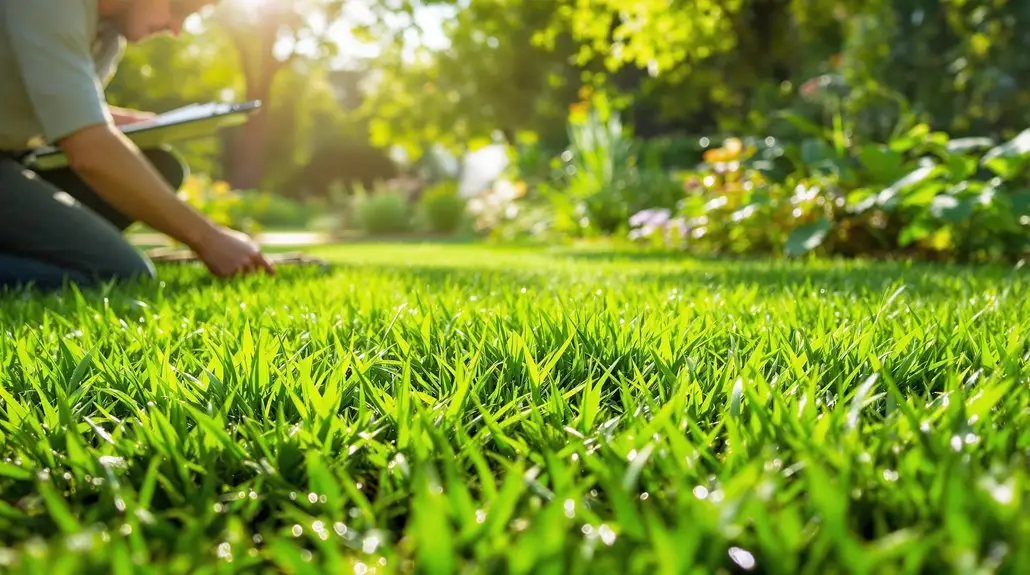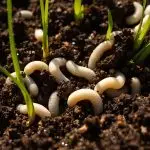Podcast: Play in new window | Download
Subscribe: Apple Podcasts | RSS
Eco lawn care backed by university studies provides effective ways to maintain your lawn sustainably. You’ll want to start with soil testing to identify nutrient needs and enhance health with organic fertilizers. Effective watering strategies, like deep watering and timing, will promote deeper roots. Mowing correctly with sharp blades and maintaining equipment reduces disease risks. Consider integrated pest management to minimize chemical use while addressing pest issues. Plus, using native plants can save water and attract wildlife. Discover how these practices come together to create a healthier lawn and environment. More insights await you on this journey to eco-friendly lawn care.
Key Insights
- University studies emphasize the importance of soil testing to identify nutrient deficiencies and promote sustainable lawn care practices.
- Research shows that organic fertilizers enhance soil health, support microbial communities, and reduce environmental impact compared to chemical fertilizers.
- Studies indicate that efficient watering strategies, such as deep watering and early morning schedules, improve lawn resilience and reduce disease risk.
- University findings highlight the benefits of native plants, including lower maintenance needs and reduced water expenses, compared to traditional lawns.
- Research supports the use of eco-friendly lawn equipment, such as electric mowers, to minimize emissions and promote sustainable landscaping practices.
Importance of Soil Testing
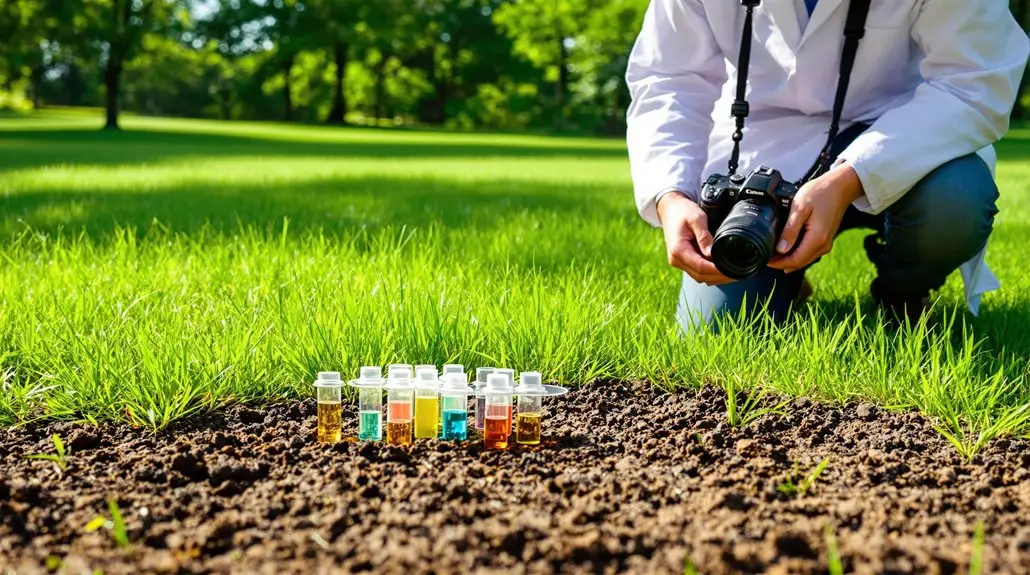
When you think about creating a vibrant, healthy lawn, soil testing mightn’t be the first thing that comes to mind, but it’s crucial. Understanding the nutrient levels in your soil can make a world of difference. Soil testing identifies specific nutrients your lawn lacks, like nitrogen, phosphorus, and potassium. This means you can effectively fertilize without worrying about under or over-nutrition.
Plus, it helps maintain the right balance of micronutrients necessary for robust grass growth. Additionally, soil testing identifies lacking or excess nutrients, enabling you to apply the right fertilizers for optimal growth. Implementing Integrated Pest Management (IPM) strategies alongside your lawn care can further enhance the overall health of your outdoor space.
Another critical aspect is soil pH. Testing reveals if your soil is too acidic or alkaline, which can impact nutrient availability. If adjustments are needed, you’ll know whether to add lime or sulfur. Tailoring these pH levels guarantees your grass—whether it’s Bermuda, Centipede, or Zoysia—has what it needs to thrive.
Soil testing also saves resources and minimizes your environmental footprint. By preventing overapplication of fertilizers, you protect nearby water bodies and reduce unnecessary expenses. With precise data, you can apply only what your lawn genuinely needs, enhancing the efficiency of your care efforts.
Lastly, soil testing detects harmful contaminants, guaranteeing a secure environment for your family and pets. By customizing your lawn care program based on your soil’s unique characteristics, you’ll nurture a healthy lawn that stands resilient against various challenges.
In the end, taking this simple yet impactful step brings you closer to your eco-friendly lawn care goals, fostering a sense of belonging in your community.
Benefits of Organic Fertilizers
Using organic fertilizers can greatly improve your lawn’s soil health while being kind to the environment. They enrich the soil with nutrients, boost the microbial community, and help reduce harmful runoff. Additionally, organic fertilizers provide long-lasting nutrient release, promoting robust root growth and enhancing the overall resilience of your lawn. Implementing these practices can also support environmentally friendly solutions that are safe for families and pets.
Nutrient-Rich Soil Improvement
Organic fertilizers play an essential role in improving nutrient-rich soil, offering benefits that go beyond mere fertilization. When you apply organic fertilizers, you enhance soil structure, which increases porosity and helps your lawn retain water, especially during dry spells. This addition of organic matter fosters a thriving community of beneficial microorganisms, vital for breaking down nutrients and supporting grass roots. These microorganisms don’t just add nutrients; they also enhance your lawn’s overall health. They decompose organic matter, making nutrients more accessible and aiding in disease prevention. As they flourish, they contribute to a healthier soil environment, strengthening your lawn naturally. One of the best features of organic fertilizers is their slow nutrient release. This means your grass gets consistent nourishment over time, promoting healthy root growth without the risk of fertilizer burn. Additionally, organic fertilizers support beneficial microorganisms that enhance soil health, further contributing to your lawn’s vitality. As a result, you’ll see lush, vibrant grass that’s resilient against pests and diseases. Furthermore, using organic fertilizers aligns with sustainable practices that minimize chemical usage, supporting the holistic approach valued by companies like NaturePest.
Environmental Impact Reduction
Enhancing your lawn’s health with organic fertilizers not only improves soil quality but also considerably reduces environmental impacts. By choosing organic options like compost and manure, you’re helping maintain soil structure, which prevents erosion and keeps your topsoil intact. This approach also improves your lawn’s water retention, minimizing runoff and protecting nearby waterways.
You’ll appreciate that organic fertilizers release nutrients slowly, which reduces the risk of chemical leaching into groundwater. Unlike their synthetic counterparts, they don’t contain harmful substances that can contaminate our precious water sources. This means cleaner lakes and rivers, supporting healthier ecosystems and vibrant aquatic life. Additionally, organic fertilizers enhance microbial activity, which further improves soil structure and fertility.
Moreover, using organic fertilizers contributes to minimizing greenhouse gas emissions. They enhance the soil’s ability to sequester carbon and reduce the release of gases like nitrous oxide.
Enhanced Soil Microbiome Health
A thriving soil microbiome is essential for maintaining a healthy lawn, and the benefits of organic fertilizers play a significant role in this. When you use organic fertilizers, you’re not just nourishing your grass; you’re enhancing the entire ecosystem beneath your feet.
These fertilizers boost soil carbon and nitrogen levels, leading to improved fertility and a more balanced pH, which can be beneficial for many plants. Furthermore, healthy microbial communities promote crop growth, ensuring that your lawn remains lush and vibrant.
You’ll notice that organic fertilizers increase microbial diversity, fostering a stable community of beneficial bacteria like *Actinobacteria* and *Proteobacteria*. This diversity helps with critical processes such as nitrogen fixation and nutrient solubilization.
Plus, the breakdown of organic matter improves soil structure and water retention, making your lawn resilient during dry spells.
Using organic options also promotes plant growth and stress tolerance. The growth-promoting hormones produced by biofertilizers enhance nutrient uptake and overall plant health.
As you embrace organic fertilizers, you’re not just caring for your lawn; you’re contributing to a healthier environment. Together, we can cultivate a thriving community of healthy plants and soil, creating a beautiful space for everyone to enjoy.
Effective Mowing Techniques

When it comes to maintaining a lush and healthy lawn, mastering effective mowing techniques is crucial. Start by choosing the right mowing pattern for your lawn’s shape. For wide lawns, mow horizontally, while vertical mowing works best for long stretches. If you’ve got obstacles like trees or flower beds, consider circular patterns that make maneuvering easier. Using different mowing patterns can also help prevent the grass from leaning in one direction, helping keep your lawn looking vibrant.
Changing your mowing pattern each time also prevents the grass from leaning in one direction, helping keep your lawn looking vibrant.
Don’t forget about mower blade maintenance! Keep those blades sharp to guarantee clean cuts—dull blades tear the grass and can lead to diseases. Aim to cut grass at 3 to 3.5 inches and remember to adjust the height according to the season and grass type, but never while the engine’s running.
Timing is everything. Mow when the grass is dry to avoid clogging your mower and to let clippings act as a natural fertilizer. Early morning or late evening are the best times to mow, as cooler temperatures help retain moisture in the roots. Instead of sticking to a strict schedule, mow based on your grass’s growth and the season.
Lastly, clear away any debris before mowing and remember to mow side to side on slopes to stay protected. By incorporating these effective mowing techniques, you’ll help foster a healthy lawn that not only looks great but also contributes to the environment.
Efficient Watering Strategies
Watering your lawn efficiently not only conserves water but also promotes healthier grass growth. To achieve this, aim to water early in the morning, ideally between 6 a.m. and 10 a.m. This timing reduces evaporation and prevents fungal growth, allowing your grass to soak up moisture before the day’s heat kicks in.
Avoid watering in the evening, as it can lead to prolonged dampness, increasing the risk of diseases. If you water in the afternoon, you could lose up to 30% of your water to evaporation.
When it comes to depth and frequency, try to water deeply and less often. This encourages roots to dig deeper into the soil, making your lawn more resilient during dry spells. Aim for 1 to 1.5 inches of water weekly, either from rainfall or irrigation, and consider using a rain gauge to measure it accurately. Deep watering is a recommended practice to support overall lawn resilience.
Watering 1 to 3 times a week is more beneficial than daily shallow watering.
You can also enhance your watering efficiency with the right tools. Sprinkler systems with timers help you deliver water at ideal times, while drip irrigation and soaker hoses direct moisture right to the roots. Smart controllers that adjust based on weather conditions can further improve your watering schedule.
Lastly, be mindful of your soil and grass type. Regularly check soil moisture to know when to water, especially during hot spells.
Integrated Pest Management

Effective pest management is essential for maintaining a healthy lawn, and Integrated Pest Management (IPM) offers a thorough approach to achieve this. IPM is an ecosystem-based strategy that emphasizes long-term prevention of pests while minimizing damage. Government agencies endorse IPM practices, highlighting its importance in sustainable pest control. In Florida, common pests such as roaches and ants can significantly impact lawn health and should be monitored closely.
By managing both insects and weeds, you can create a balanced environment that protects not only your lawn but also beneficial organisms and human health.
To get started with IPM, identify potential pests and monitor both pest populations and their natural enemies. Establish thresholds for when action is necessary, allowing you to respond effectively without overreacting.
Implement preventive cultural practices, like choosing pest-resistant turfgrass and maintaining healthy grass through proper mowing and watering.
Utilize biological control methods by introducing natural predators or competitors to manage pests naturally. Mechanical control, such as traps and barriers, can also be effective.
Chemical control should be your last resort, applied only when absolutely necessary and with careful consideration of the environment.
Eco-Friendly Lawn Equipment
Maintaining an eco-friendly lawn is easier than ever with the right equipment at your disposal. By choosing the right tools, you can contribute to a healthier environment while keeping your lawn looking great. Here’s a quick comparison of some eco-friendly lawn mowers that may suit your needs:
| Type of Mower | Key Features |
|---|---|
| Manual Reel Mowers | Zero-emission, lightweight, scissor-like cut |
| Corded Electric Mowers | No emissions, quiet, low maintenance |
| Battery-Powered Mowers | Cordless, rechargeable, ideal for medium lawns |
| Electric Riding Mowers | Energy-efficient, fewer emissions |
When selecting your equipment, consider features that enhance usability and performance. Look for cutting width options to match your lawn size, adjustable cutting heights for various grass lengths, and mulching capabilities that return nutrients to your soil. Lightweight designs make pushing easier, especially for manual and corded mowers. Electric mowers typically have a smaller carbon footprint compared to gas mowers, which further emphasizes their environmental advantages.
Not only do these eco-friendly mowers reduce emissions and noise pollution, but they also conserve resources. Electric mowers may have a higher initial cost, but they save you money on maintenance and operation in the long run. With warranty options and energy-efficient designs, you’ll be investing in a sustainable solution that supports both your lawn and the planet.
Join the movement towards greener lawn care—your choices today can lead to a brighter, cleaner tomorrow!
Enhancing Soil Health
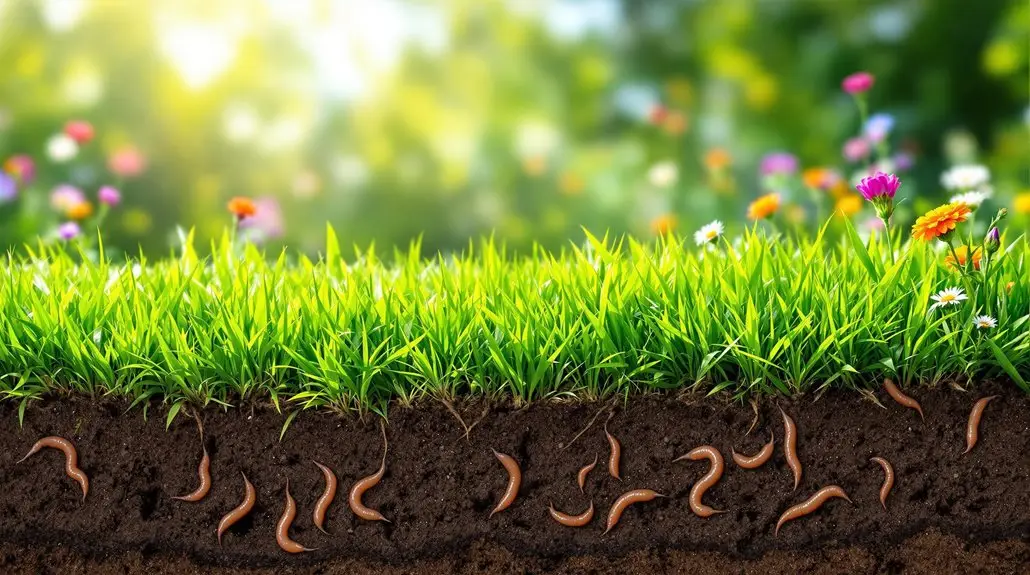
To cultivate a thriving lawn, enhancing soil health is vital. You can start by improving your soil structure. Adding organic matter like compost, manure, and cover crops will boost soil aggregation and stability. Aim for that loamy soil mix of sand, silt, and clay for the ideal balance of water infiltration and nutrient availability.
If your soil leans sandy, organic matter will help it retain water. On the flip side, if you’re dealing with clay, consider amendments to improve drainage and aeration.
Next, focus on enhancing nutrient availability. Organic matter is packed with essential nutrients like nitrogen, phosphorus, and potassium. Composting not only recycles waste but also introduces beneficial microorganisms that break down organic material, releasing nutrients for your plants. Sup-R-Soil can significantly improve your soil’s nutrient content, ensuring a more vibrant and resilient lawn.
Remember, keeping your soil pH between 6.0 and 7.0 is vital for optimal nutrient uptake.
Don’t forget about promoting microbial activity. Encouraging these tiny allies helps break down organic matter and makes nutrients accessible to your plants. Healthy microbial activity also acts as a protective shield against diseases by outcompeting harmful pathogens.
Promoting Native Plants
When you promote native plants in your garden, you’re choosing low-maintenance solutions that thrive in your local climate and soil.
These plants not only require less care but also attract local wildlife, creating a vibrant ecosystem right in your backyard.
Plus, by incorporating native species, you’ll contribute to a healthier environment and reduce your overall maintenance costs.
Benefits of Native Plants
Embracing native plants in your landscape not only enhances its beauty but also brings a multitude of benefits that support both your wallet and the environment.
These plants thrive with the natural rainfall in your area, considerably reducing your irrigation needs and water expenses. Their deep root systems hold water more efficiently, minimizing runoff and helping to prevent flooding.
Once established, native plants require little maintenance, saving you time and money. They’re more resistant to local pests and diseases, meaning you won’t need to frequently replace them or use harsh chemicals.
In fact, over a 10-year period, maintaining a traditional lawn can cost you five times more than a native plant landscape.
Additionally, native plants contribute to environmental sustainability. They don’t create air pollution like gas-powered lawn equipment and help store carbon in the soil, combating climate change.
These resilient plants stabilize the soil, reducing erosion, and improve water quality by filtering rainwater.
Attracting Local Wildlife
Attracting local wildlife to your garden is easier than you might think, especially when you incorporate native plants into your landscape. By choosing plants like milkweed, black-eyed Susans, and elderberry, you create a welcoming environment for hummingbirds, butterflies, and birds.
Native plants provide essential nectar and protein-rich pollen, directly supporting the survival of pollinators such as native bees and monarch butterflies.
Imagine seeing goldfinches feasting on sunflower seeds or butterflies fluttering around your blooming garden. These species thrive on the food sources native plants offer, and they in turn enhance the beauty and vibrancy of your space.
Aim for at least 70% native plants in your garden to effectively support local bird populations, and watch as your garden becomes a lively habitat.
Not only do native plants require less water and care once established, but they also foster biodiversity, drawing in a variety of wildlife.
By cultivating native plants, you’re contributing to a healthier ecosystem, creating a sanctuary for furry friends, feathered visitors, and pollinators alike.
Embrace the joy of belonging to a community that cherishes and nurtures nature right in your backyard.
Low Maintenance Solutions
Creating a vibrant garden filled with local wildlife doesn’t have to mean spending countless hours on maintenance. By choosing native plants, you can create a thriving ecosystem that requires minimal effort.
These plants are perfectly adapted to your local climate and soil, which means they thrive on natural rainfall and develop deep root systems to access moisture. Once established, they need little to no extra watering, saving you time and reducing your water bills.
You’ll also find that native plants don’t require chemical fertilizers or pesticides. They’re naturally resilient against pests and diseases, making your garden more secure for beneficial insects and cleaner for local water sources.
This approach promotes healthier soil and reduces the time you spend worrying about chemicals.
Moreover, native plants require less pruning and mowing, giving you more time to enjoy your outdoor space. They adapt seamlessly to various light conditions and even tolerate poor soil. Additionally, using organic-compliant methods can enhance the overall health of your garden ecosystem while minimizing environmental impact.
Sustainable Lawn Alternatives
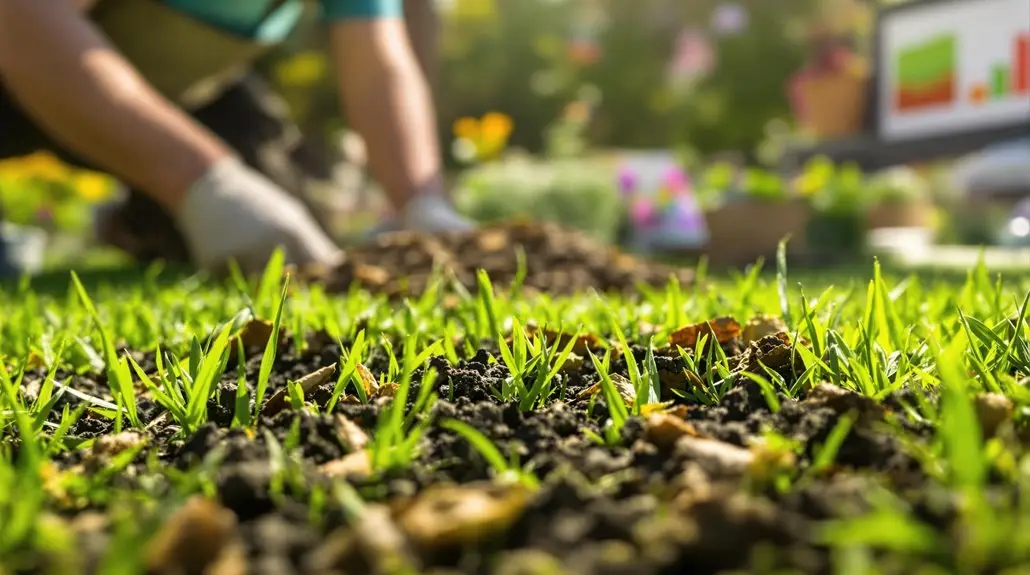
For those looking to reduce their environmental impact while maintaining an attractive outdoor space, sustainable lawn alternatives offer a practical solution. By opting for eco-friendly groundcovers like creeping thyme or red-tinged creeping sedums, you can create a lush, vibrant landscape without the hassle of mowing or extensive fertilization.
These low-growing plants thrive in various regions and contribute to local biodiversity, as long as you choose native species.
Another great option is to embrace native plants and wildflower meadows. They’re not only beautiful but also require minimal water and maintenance. With just one annual mow, you’ll support local ecosystems by providing food and shelter for butterflies, bees, and birds.
Just be sure to avoid invasive species in your wildflower blends to keep the balance intact.
If you prefer a more traditional look, consider low-mow or no-mow grass alternatives like hard fescue or buffalograss. These grasses reduce your carbon footprint and require less water and fertilizer than standard turfgrass, making them a smart choice for environmentally conscious homeowners.
Lastly, xeriscaping and hardscaping are fantastic approaches for reducing water usage. By selecting drought-tolerant plants and incorporating permeable materials, you can create stunning outdoor spaces that thrive on natural rainfall.
With these sustainable lawn alternatives, you’ll not only enhance your landscape but also foster a sense of community stewardship for the environment.
Frequently Asked Questions
How Often Should I Test My Soil for Nutrients?
You should test your soil every three years to keep track of its nutrient levels and health.
If you notice any issues like yellowing grass or poor growth, consider testing more often. Testing before planting a new lawn or after major changes can also help guarantee your soil has the right nutrients.
Spring and fall are the best times for testing, allowing you to make necessary adjustments for ideal growth.
What Are the Signs of Nutrient Deficiency in My Lawn?
Much like a struggling artist’s palette, your lawn can reveal nutrient deficiencies through specific signs.
If you notice yellowing leaves, stunted growth, or bald spots, it’s time to investigate. A purple hue might signal phosphorus issues, while older leaves turning yellow could point to potassium trouble.
Keep an eye out for interveinal chlorosis, too. By recognizing these signs, you’ll nurture a vibrant, healthy lawn that belongs to your home’s landscape.
Can I Use Homemade Compost on My Lawn?
Absolutely, you can use homemade compost on your lawn! It improves soil structure, provides essential nutrients, and supports beneficial microbial activity.
Just spread a thin layer over your grass, and consider aerating first for better absorption. Water it in afterward to help the compost settle.
Whether you’ve got warm-season or cool-season grass, your lawn will thrive with this natural boost. It’s a simple way to create a lush, healthy yard everyone can enjoy!
What Types of Native Plants Are Best for My Region?
Choosing native plants for your region is like painting a landscape with local colors.
You’ll want to contemplate regional natives, which thrive in your specific environment. Look for plants that naturally grow within 90 miles of your home, as they’ll adapt beautifully to your soil and climate.
These plants don’t just beautify your garden; they create a welcoming habitat for wildlife and help preserve the unique charm of your local ecosystem.
How Can I Encourage Beneficial Insects in My Garden?
To encourage beneficial insects in your garden, mix native plants, herbs, and flowers.
Plant early bloomers like alyssum and late bloomers like asters for a continuous food source.
Create diverse habitats with wood piles and bee hotels.
Avoid pesticides and maintain healthy soil to support insect life.
Regularly check your plants to catch any issues early.
Transform Your Lawn, Transform the Planet: Choose Eco-Friendly Care with NaturePest!
By implementing eco-friendly lawn care practices, you’re not just creating a beautiful yard; you’re contributing to a healthier environment. For instance, a suburban family in Oregon switched to organic fertilizers and native plants, resulting in a vibrant, low-maintenance lawn that attracts local wildlife and reduces water usage by 30%. Embracing sustainable methods like these not only enhances your lawn but also supports biodiversity and soil health, proving that caring for the planet can start right in your backyard.
Take the first step towards a greener future today! Partner with NaturePest Holistic Pest Control to ensure your lawn care practices are safe for your family and the environment. By choosing our eco-friendly solutions, you can maintain a healthy lawn while protecting local ecosystems. Join us in making a positive impact—contact NaturePest now and transform your yard into a thriving sanctuary for all!

